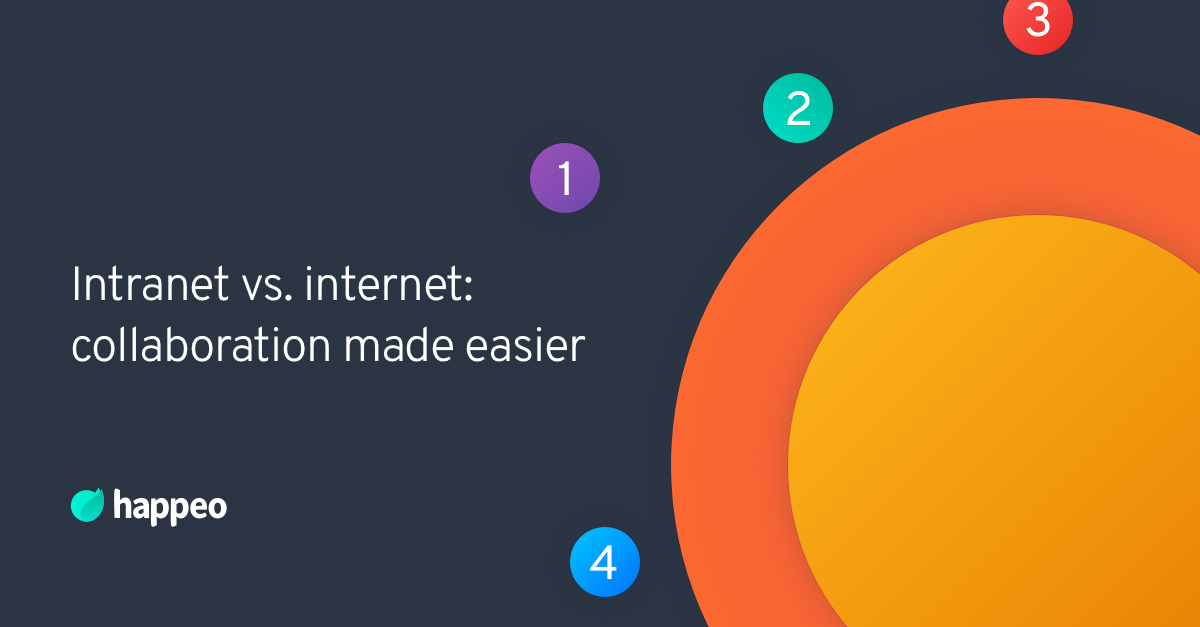
Internal Communications Comparisons
SaaS internet tools vs bundled intranet solutions

8 mins read
Start building your digital home with Happeo
Request a demoInternal Communications Comparisons
Product
Features
Solutions
Happeo for
Use cases
Resources
Explore
Support
Happeo For
Use cases
Comparisons
Explore
Support
Recent

Jonathan Davies
8 mins read
You’ve heard the idea of the new digital workplace. You’ve heard that upgraded intranet systems could be the solution to your enterprise’s Internal Communication and collaboration issues; that it could connect all of your employees across the globe in one, centralized platform.
So...what about the internet vs. intranet debate?
Can’t the internet satisfy all of your enterprise’s communication needs? It has a plethora of opportunities available that include the same features of an intranet, while still connecting everyone online. Is it really necessary to purchase a unified intranet software solution for your employees to collaborate and function well?
While it’s true that the internet and SaaS (Software as a Service) collaboration tools do provide modern, relevant services, what they lack is the integration factor of the intranet. Bringing everything together creates efficiency and simplicity in your workplace, resulting in measurable intranet success and productivity improvements for your enterprise.
The internet offers different kinds of SaaS tools to communicate and collaborate. These tools and apps are digital age’s new way of obtaining software. SaaS is a distribution model of software in which customers access software over the internet, often foregoing the need to install it on a local machine.
The host owns and distributes the software, usually through a monthly subscription, and the customers access it through the internet using their own device. These software apps are regularly updated and easily accessible through any device that connects to the internet. Common features that these SaaS solutions provide are:
While these are revolutionary tools for the business world, they still are not a holistic solution to the digital workplace. Even though some SaaS and collaboration tools integrate with other apps, you will still find yourself and your employees logging into ten different platforms before the day has even started. Isolated platforms create information silos. SaaS tools don’t talk to each other, so you are left switch back and forth between them, losing time searching for contextual information that is vital to your tasks. In the end, you lose all the productivity boosts these solutions were meant to bring.
This is where intranet software steps in. The difference between the intranet and internet is that intranet software breaks those silos down via complete integration, so you no longer have ten different logins that don’t work together. Instead, you have a complete system that incorporates all the working parts of your digital workplace – in one central platform.
SaaS tools provide multiple options for different communication, collaboration and project management tool. With hundreds to thousands of different solutions to choose from, you can almost certainly find something that will meet the needs of your enterprise. The benefits to SaaS solutions are that they can be accessed from any device, at any time, and they provide opportunities for collaboration throughout your workplace.
Some leading examples of SaaS tools are:
These tools can streamline your enterprise’s communication between departments, make it easier to stay connected, revolutionize your data management, and help launch your business into the modern, digital age.
While the options and choices may be overwhelming, most SaaS tools have a specialty. This makes it easier to find and choose what you need, but it also means you will likely need to look into multiple software solutions. While one solution may be phenomenal at meeting one aspect of your enterprise’s needs, you will need to obtain others to fill all your needs, creating a more holistic solution. So while it may seem more economical to subscribe to multiple SaaS tools, in the long run it could end up costing your enterprise more money because you will need to purchase more software than you originally thought. Combining isolated SaaS tools will simply not set your enterprise up for success the way intranet software could.
The other issue with SaaS solutions is that they create silos within the workplace. If you choose this route, your enterprise will have information and conversations stored in multiple places, which means this data is more likely to either fall through the cracks or be duplicated unnecessarily. What we see as a result from using only SaaS tools is collaboration defragmentation. Without a unified system, you will start seeing this divide spread throughout your enterprise. For example, while one department may latch on to DropBox for their data sharing platform, the next department may stick with Google Drive or Docs as their preferred platform. This means that these two departments will remain disconnected in their information sharing, and the productivity these solutions are meant to bring will be lost.
While it seems like the internet should be able to provide all the necessary tools to run a modern-day enterprise through SaaS software, the issue is that all these options remain scattered throughout the world wide web.
The difference between the internet and an intranet is that the internet applications leave your company scattered, while successful intranet software brings everything you are looking for together in one organized, efficient space. Successful intranet systems cover all of the internal communication and collaboration under one large umbrella, so that every task is connected to the overarching goals and values of the organization. With intranet software, it’s one login – done. From there you can access everything that separate project management tools could offer, but instead of them being separate, it all comes together in one integrated system.
Think of a supermarket store. It is a combination of everything you could want or need all in one space. You can get toiletries, groceries, home goods, appliances, greeting cards, school supplies, clothing – even magazines of questionable intent. It’s all under one roof, no need to travel to different, specialized stores for each product. This is exactly what a successful intranet system offers. Instead of having to travel and navigate through different, specialized SaaS platforms that will inevitably end up wasting time, your employees can log in to the intranet system. It’s their one-stop shop for the day.
Most intranet software will offer these features in the same platform:
Document and content management – There should be a space to manage all of your company’s documents including worksheets, slide shows, creative assets – basically anything you can store online. It should also include an easy way to create content for your employees.
Task management – There should be an easy way for employees and managers alike to keep up on tasks, visually map out projects and allow cross-department collaboration.
Social tools and search – Each employee should have their own, all-inclusive profile that lays out their specific skills and all relevant information. This tool should also be available so employees can socialize – think of features like comments, edits, or reactions to any type of post within the intranet system.
Mobile app – To truly be called a ‘digital workplace’, every successful intranet solution should include a mobile app feature that keeps employees connected – anytime, anywhere. This should be an easy to use interface and should include things like notifications to facilitate immediate communication.
Integration – Not only are intranets completely integrated within their own systems, but a good intranet solution should also be compatible with other SaaS tools your company is using. The benefit of incorporating them into your intranet having everything combined into that one login, reducing the inefficiency of switching from app to app or page to page.
“I think the best feature about Happeo, besides the social side, is the People section with the visual organizational chart. That is something very unique, useful and original.”
“Ability to reflect our brand perfectly. I didn't think we could create such an impactful intranet that easily! It's so easy to use, both from a content management point of view and the front end user; a really intuitive platform. There's a multitude of easy to use (and move) widgets to create really engaging pages. The apps & tools area ensures that employees go to the intranet first to find their other applications. Powerful search functionality.”
Information sharing – A fully adopted and implemented intranet solution is the place your employees will go to complete daily tasks. By sharing company-wide information through your intranet platform you eliminate contextual switching, and also make information easy to locate and access. When it's all in one place, anyone from any department has access to the same information.
Cross-department communication – communication wise, intranet software won’t allow different departments to stick to certain apps that other departments might not enjoy using. This will open up a company-wide dialogue that will connect instead of divide, creating a culture of open communication and trust within your workplace.
Cultivate your values – Siloed solutions leave no space for large company dialogue to take place. The more software there is, the less likely it becomes that all of your employees will be logging in to check what’s happening with the company at large. But, if everything is brought together into an intranet software, employees will be going there exclusively for information and tasks. That means everyone will be on the same page – literally. Your enterprise can instill its brand and core values more effectively too. Keeping up with relevant, quality dialogue between employees can be beneficial for you as well. If new employees can come in and have access to all the communication that happens within the enterprise, they will have a much better understanding of how this work and what the workspace culture is.
Format across the board – Having an intranet solution gives you the opportunity to create a standardized format for your whole enterprise, making it easy for employees to create and share content in a way that closely resembles your brand. Pre-made formatting is also an easy way to ensure that your intranet portal will remain uncluttered and look professional.
The bottom line: find what works for you
While there may appear to be communication and collaboration tools that are better than others in running a business, the bottom line is that you need to look for what fits best for your enterprise. Think about your enterprise’s specific pros and cons in the intranet versus internet debate. Ask yourself these questions, and decide what solutions will best fulfill the needs from the answers:
While one or two SaaS solutions may seem like a perfect fit, make sure to weigh the costs of having multiple, siloed software that can’t integrate with each other, versus having a fully integrated solution that could even solve unforeseen issues in your company.
